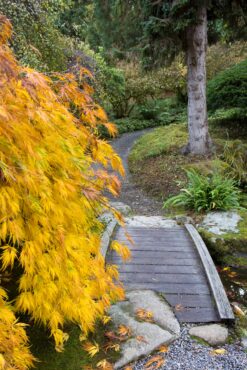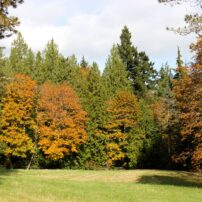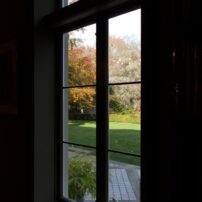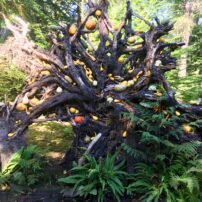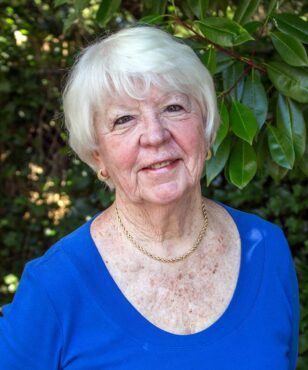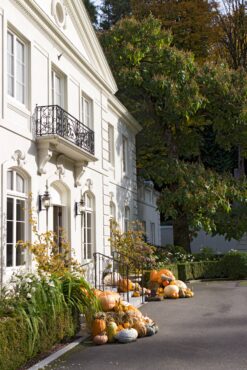 The Kitsap Peninsula is privileged to be home to one of the nation’s most magnificent landscape gardens, just over the Highway 305 bridge on Bainbridge Island. Touted as “one of North America’s 10 best botanical gardens,” Bloedel Reserve is unique in its focus, combining exquisite vistas within a natural setting and featuring stately trees, ponds and gardens connected by pathways that invite the visitor to wander and explore.
The Kitsap Peninsula is privileged to be home to one of the nation’s most magnificent landscape gardens, just over the Highway 305 bridge on Bainbridge Island. Touted as “one of North America’s 10 best botanical gardens,” Bloedel Reserve is unique in its focus, combining exquisite vistas within a natural setting and featuring stately trees, ponds and gardens connected by pathways that invite the visitor to wander and explore.
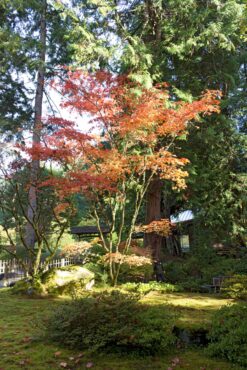 Though the gardens are lovely in every season, autumn is one of the best times to enjoy Bloedel’s colorful foliage. Eastern “leaf trekkers” might think they have the finest fall color but Northwest deciduous trees, as they go through the autumn transition before dropping their leaves, are even more stunning contrasted against the backdrop of huge firs, cedars, hemlocks and other evergreens.
Though the gardens are lovely in every season, autumn is one of the best times to enjoy Bloedel’s colorful foliage. Eastern “leaf trekkers” might think they have the finest fall color but Northwest deciduous trees, as they go through the autumn transition before dropping their leaves, are even more stunning contrasted against the backdrop of huge firs, cedars, hemlocks and other evergreens.
If you’re looking for an autumn outing, you won’t find a better one than a walk through the reserve during the months of September and October. Of course, the maples are the most obvious stars of the show in their various shades of red from crimson to burgundy, purple, orange and yellow. Native bigleaf maples dress their huge leaves in bright gold. Along “Maple Lane,” there are Japanese maples, coral bark maples, paperbark maples and lion’s mane maples in all their glory.
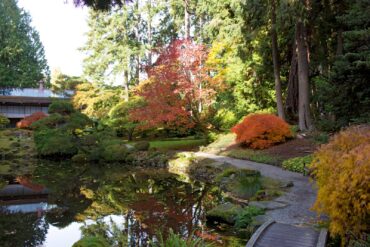 One of the best views is from the porch of the Japanese Guest House: a photographer’s dream shot with the pond below reflecting the colors of the surrounding trees. Two other ponds in the garden provide ample opportunities for shots of mirrored, dark-green evergreens and a kaleidoscope of autumn, deciduous leaf color. The long view of the residence from the far shore of the Mid Pond can match any vista an elegant English estate garden can offer.
One of the best views is from the porch of the Japanese Guest House: a photographer’s dream shot with the pond below reflecting the colors of the surrounding trees. Two other ponds in the garden provide ample opportunities for shots of mirrored, dark-green evergreens and a kaleidoscope of autumn, deciduous leaf color. The long view of the residence from the far shore of the Mid Pond can match any vista an elegant English estate garden can offer.
Not to be outdone by the maples, the birches, poplars, sweetgums and red alders put on a spectacular show as well. If you are searching for certain specimens, look in the following areas:
- By the sheep sheds: golden locust and tulip poplar
- Bird marsh and meadow: Chinese tupelo, vine maple
- At the steep bank: huge ironwood tree
- By the residence: katsura and copper beech
- In the Japanese Garden: golden locust, Japanese maples (of course), Korean dogwood, stewartia, Japanese larch, weeping birches, weeping katsura
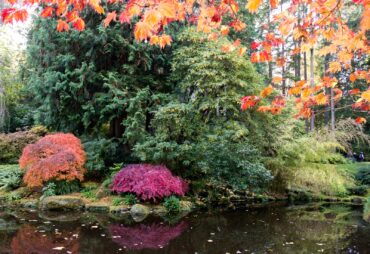 Keep an eye out for interesting bark colors and texture. You’ll see some eye-catching bark on birch trees with white bark; paperbark (Acer griseum) with peeling cinnamon-colored bark; stewartia with exfoliating gray, red and orange bark; and coral bark maples with brilliant red-coral bark.
Keep an eye out for interesting bark colors and texture. You’ll see some eye-catching bark on birch trees with white bark; paperbark (Acer griseum) with peeling cinnamon-colored bark; stewartia with exfoliating gray, red and orange bark; and coral bark maples with brilliant red-coral bark.
While you are feasting your eyes, remember to take a nice, deep breath of fresh Northwest air. There’s nothing like that crisp, fall aroma. Bloedel’s communications manager, Gretchen Douma, says, “The scent of the katsura trees is what stands out the most for me. It’s super sweet.”
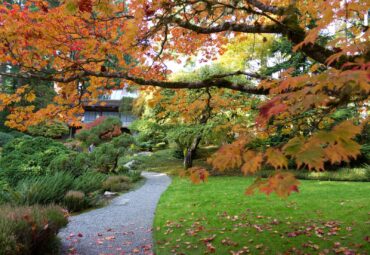 In addition to trees, the shrubs and groundcovers also take on autumn hues. Throughout the garden, you’ll see shrubs such as witch hazel, Fothergilla, heathers, Plumbago, winterberry and Japanese spice bush, all done up in their copper-reds to crimsons, bronze oranges, buttery yellows and golds. For gardeners who love the look of Japanese forest grass, be sure to check out the impressive citron yellow stand on the back bank by the residence.
In addition to trees, the shrubs and groundcovers also take on autumn hues. Throughout the garden, you’ll see shrubs such as witch hazel, Fothergilla, heathers, Plumbago, winterberry and Japanese spice bush, all done up in their copper-reds to crimsons, bronze oranges, buttery yellows and golds. For gardeners who love the look of Japanese forest grass, be sure to check out the impressive citron yellow stand on the back bank by the residence.
Though not exactly a fall-color highlight, the Moss Garden is a unique part of the Bloedel Reserve. A place of green and serene natural beauty, it should not be missed on your visit. You get the feeling there may be fairies lurking behind some of those mossy stumps, reminding you not to forget that green is a color too.
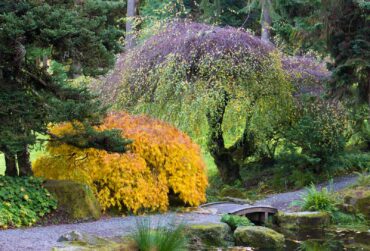 An October tradition at Bloedel and a major highlight is the pumpkin- and squash-display and the Super Squash Scavenger Hunt. The pumpkins and squash are cultivated on the property during the summer to be ready for fall. Hundreds of them are arranged in amazing displays throughout the garden and around the residence. Hundreds are also hidden around the grounds for visitors to find and identify with the aid of a map: a fun challenge for adults and children alike.
An October tradition at Bloedel and a major highlight is the pumpkin- and squash-display and the Super Squash Scavenger Hunt. The pumpkins and squash are cultivated on the property during the summer to be ready for fall. Hundreds of them are arranged in amazing displays throughout the garden and around the residence. Hundreds are also hidden around the grounds for visitors to find and identify with the aid of a map: a fun challenge for adults and children alike.
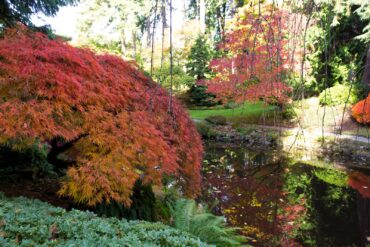 The nice thing about Bloedel is that it offers various types of walks for various levels of walkers. You’ll receive a map of the property when you arrive. Those wishing a longer and more vigorous hike may choose to take the trail out to the sheep sheds and the Buxton Bird Marsh and Meadow, then loop back to the paths that meander through the woodsier parts of the garden.
The nice thing about Bloedel is that it offers various types of walks for various levels of walkers. You’ll receive a map of the property when you arrive. Those wishing a longer and more vigorous hike may choose to take the trail out to the sheep sheds and the Buxton Bird Marsh and Meadow, then loop back to the paths that meander through the woodsier parts of the garden.
For a shorter and less vigorous walk, you can stay on the main paths and take in the Moss Garden, Japanese Garden, Reflecting Pond and the Residence. A medium route would be to take the trail toward the sheep sheds but circle back around to the reflecting pond and continue on the main paths.




